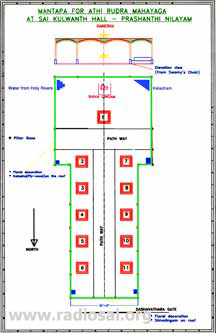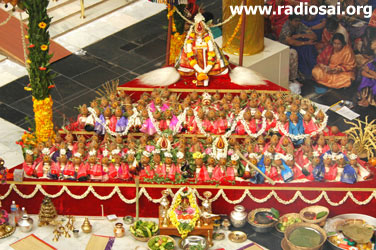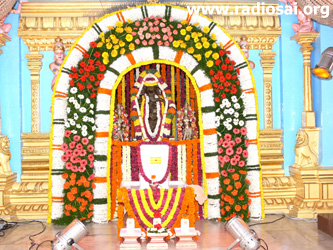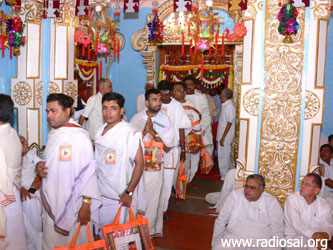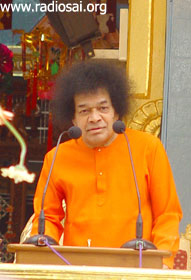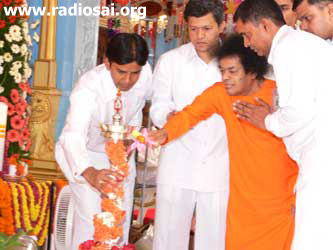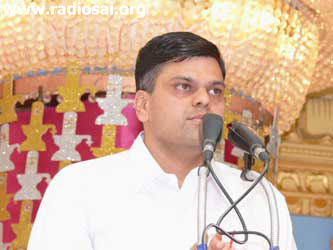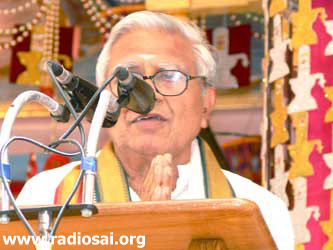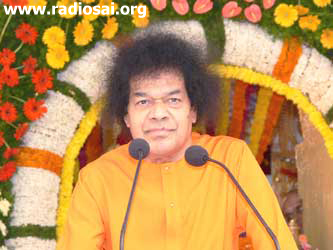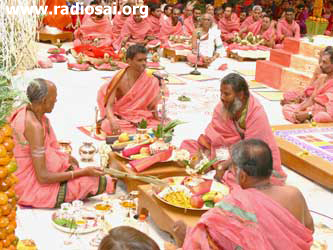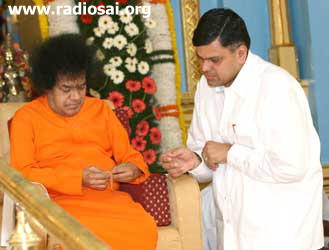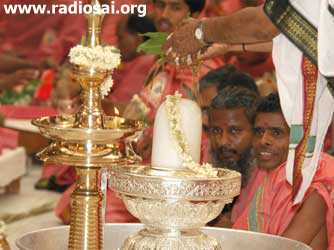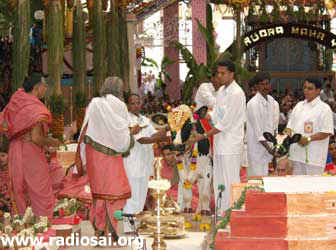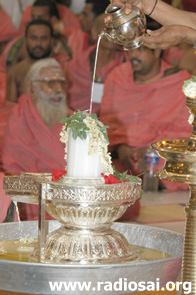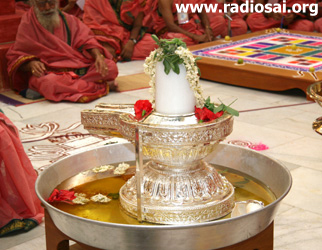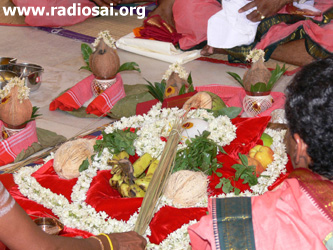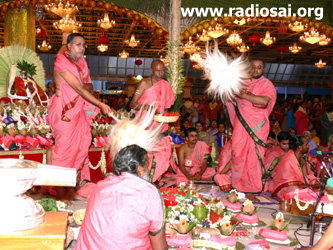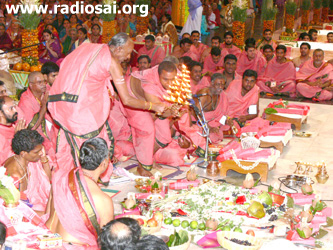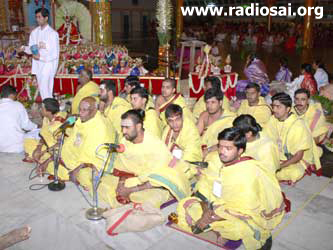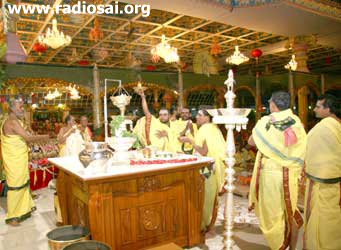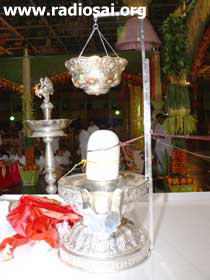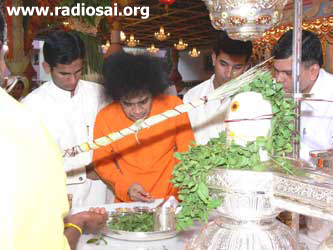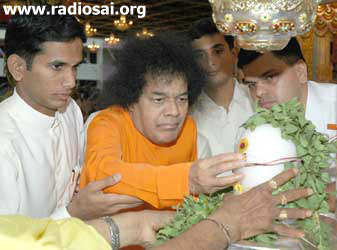|
PRASHANTI DIARY - part 2
Eleven recitations of the Sri Rudram (Namakam) followed by one recitation of the Chamakam is called the Ekadasa Rudram. This also constitutes one unit of the Rudra Homam. Eleven Ekadasa Rudram recitations make one Laghu Rudram. (11x11=121 times of Namakam and 11 times recitation of Chamakam). This is achieved if 11 priests chant 11 times the Namakam and 1/11 of the Chamakam for every single recitation of the Namakam. [Editor’s Note: The Namakam and Chamakam are each divided into 11 anuvakyas or sections. Hence for each recitation of the Namakam they chant one anuvakya or 1/11 portion of the Chamakam]. Eleven Laghu Rudram recitations make a Maharudram (11x11x11=1331 Namakams and 121 Chamakams). This is achieved if everyday 11 priests chant 11 times for 11 days. And eleven Maharudram recitations make an Ati Rudram! Thus, in an Athi Rudra Maha Yagnam, the Namakam will be recited 14,641 times and the Chamakam 1331 times, with the performance of 1331 Rudra Homams by 121 Ritvik priests. (121 priests x 11 times per day over 11 days). So one can ask the question - if this yagnam is being performed since time immemorial for conferring spiritual benefit and for loka kalyanam and loka kshema, what is the necessity of reciting the Chamakam, which confers mere material benefits. The Chamakam (in this context) is now a prayer to the Lord to provide all the articles required for the homam. The list is exhaustive and comprehensive, from lentils of several varieties, to fuel, ghee and fruits. The usage of material things in the service of the Lord is after all one of the highest form of devotional service. The 121 priests are spread over 11 homa kundams (fire pits), with each kundam associated with 11 priests. Apart from these 121 priests there will be 14 other priests who will do pujas to various deities, thus totalling to 135 ritviks who will take part in this yagnam. A detailed explanation of the importance of the number 11 is given in the box below.
As per the ‘Kurma Purana’ this Athi Rudra Maha Yagna was performed in Dwapara Yuga by Lord Krishna. In the Treta Yuga, Lord Sri Rama also performed the same as per Hindu Vedic scriptures. This is the first time in the history of Kali Yuga that this yagna is being performed when Lord Sathya Sai is in the “Siva Sakthi” avatar amidst us as Lord Rudra. This yagnam was started on August 9th, when ‘Sravana’ star was in sway (which is the birth star of Lord Vishnu) and ended on August 20 th in ‘Aarudra Star’ (which is the birth star of Lord Sathya Sai).
Every evening after the conclusion of the afternoon (and the day’s) ceremony all the priests took their places in front of the veranda and it was the turn of one or two eminent speakers to educate everyone on one aspect of Shiva or to elucidate some aspects of the yagnam that was being conducted. All these speakers were either accomplished Vedic scholars or eminent men known for their deep spiritual knowledge and all of them held everyone spellbound with their oratory and the sheer wealth of the spiritual experience that they shared with the audience every day. And on almost all evenings, Swami also pleasantly surprised everyone with His divine discourse. And after the speeches there would be devotional songs either by budding artistes from Karnataka or on Swami’s command the SSSIHL boys would perform.
The Function On The 9th Evening (The First Day) The evening of the 9th was the start of the yagnam. All the rithviks, chanting vedic hymns and accompanied by auspicious Nadaswaram music, entered Sai Kulwant Hall in a procession and received Swami with the Purna Kumbha. Swami lit the lamp to inaugurate the Yaaga.
After lighting the lamp, Swami took His seat on the veranda. The yagnam started with the invocation song, sung by the bhajan group from Brindavan, entitled "Athi Rudra Maha Yagna Purusha Sai". Swami asked Sri Vinay Kumar and Sri Lakshmi Narayan to speak to the audience. Sri Vinay Kumar recounted how when he had asked Swami’s permission to perform the Ati Rudra Yagnam on June 13th for Rudra’s joy and satisfaction, Swami had replied, “But I am always joyous and satisfied”. He went on to explain how the yagnam would be performed. Sri Lakshmi Narayan, also a co-organiser speaking next also related Swami’s involvement in all aspects of planning for the yagnam.
After Swami sat down, the Head priest obtained Swami’s blessing for the implements with which the puja would be done. The Yaaga then began with the Maha Ganapathi Puja, after specification of the place and time of the Yaaga in the traditional way:
"In this spacious Universe, on Earth, on the continent of Jamboodvipa, in the land of Bharat (India), in the State of Andhra, in the holy pilgrimage site of Puttaparthi on the banks of the holy Chitravathi River, in the year Vyaya, during Dakshinaayana, on the first day of the month of Sraavana, on Budhavaar ( corresponding to Wednesday, August 9, 2006), until the 12th day of the month of Sraavana, Aadivaar." (Sunday, August 20).
The milk white marble Shiva Linga was ceremoniously bathed in water in ‘Jala Proshana’. Then Purvaanga Godaana was performed. A well-decorated cow and her calf were welcomed with auspicious music and vedic hymns, worshipped with mantras according to the Shastras, and then given away to a Brahmin. Among all auspicious good deeds, the gifting of a cow is traditionally considered the highest and holiest act of charity.
The installation and consecration of the Lord in this particular image or form of the Shiva Linga, is considered equivalent to the Lord being born in this world in this form, so all of the Shastric rites conducted during birth were also performed for the Shiva Linga.
[The lingam is traditionally used to represent Lord Shiva and has a deep meaning and significance. It is considered the “amorphous’ form of Lord Shiva. The Lord is in the 3 forms i.e. the formless state of God, the lovely ash-smeared form of Lord Shiva with the blue throat and the snakes around His waist that we are all familiar with, and in the lingam – the amorphous state of formlessness and yet also with form, as the lingam has no defined beginning and end. The lingam is thus indicative of the beginningless and endless Brahman. Lingam is a combination of two words namely Leeyathe (mergence) and Gamyathe (emergence) suggestive of the creation and dissolution of the Universe]. The Shayyadheevasa ('sleeping' of the Lord) was next performed. The lingam was literally placed in a cozy bed with fruits, flowers and incense. Lullaby was sung and music played in 5 ragas as the two chamargrahas (fan bearers) gently fanned the Lord. Sentries - Indra on the East, Agni (S.E), Yama (S), Nirariti (SW), Varuna (W), Vayu (NW), Kubera (N), Shiva (NE), Brahma (above) and Ananta (below) - were posted to ensure a peaceful rest to the Lord! With these Agama Shastra Rites, the Ashtavadhana Seva, the day’s ceremonies concluded with the Maha Mangala Aarathi. As the Lord retired, arthi was sung and the eventful evening came to a close at 6:45 PM.
The Function On Aug 10th - the Second Day On the morning of the 10th, the entire ‘packed to overflowing’ hall was abuzz with excitement. At the centre of the hall was an ornate table in wood with a marble topping on which was placed the pedestal with the lingam. The priests had begun the day by getting the lingam ready for Swami to do the prana prathista (installing life in the lingam). The first ceremony was Aruna Parayana, followed by Kalaa Homa and Anga Homa. Kalaa and Aavaahana were performed for the Shiva Linga. Aavaahana was performed to all the kalashas with Veda Mantras. Before Praana Prathishtapana (invocation and consecration of the Life Force) was conducted for each kalasha, all of the necessary ceremonies required by the scriptures were performed, including “Netronmeelana” to the Siva lingam. Netronmeelana means opening of the eyes of a new born baby (in this case the Siva linga).
The white-stone lingam sat on its silver pedestal. On it was smeared a “third eye” of sandal paste and vermillion. It was decorated with a garland of bilva leaves. It had above it a silver-golden bowl, hanging from a support, with intricate carvings and studded with precious gems. This silver bowl was called the “Dhara patram”, and it had a small hole at the bottom. When this vessel was filled with a fluid – either water or milk etc., it flowed out through the hole in a continuous stream on to the lingam below, giving it an abhisekham (a ritual bath). Swami came out of the Yajur Mandir around 6:15 AM and got down from the car in front of the lingam itself where He was welcomed by the head priest with holy water to be offered to the Lingam. He was helped on to a pedestal and He sprinkled water on the lingam with the aid of a long brush braided from holy grass, while the ritual prayer was being recited by the priests.
Then to everyone’s astonished gasps, with the merest wave of His hand, Swami materialized a “third eye” for the Lingam. It was a “namam” [namam refers to the three parallel vibhuti lines that followers of Lord Shiva apply to their foreheads] of three lines made of gold plate with a red gem at its centre. Swami Himself placed the “eye” on the lingam and stuck it there and completed the picture.
The priest then performed arathi to the lingam and Swami together. Swami then went walking around the table, up the steps and took His place on the veranda. Thus after the installation of the Shiva Linga with Vedic rites, Swami Himself had performed the Praana Prathishtapana for the Shiva Linga and the Siva lingam was now born and considered to be imbued with life. The yagnam began with a song in Tamil by a 13 year old boy Karthick calling out to Lord Sankara as the mother and the father of all mankind. It set a tone of devotion to the entire proceedings. After the Birth Ceremony, the Naming Ceremony was performed. Swami Himself gave the Shiva Linga the name “Sai Easwara”. The Head priest (Sri B.S. Nanjunda Dixit) made this announcement to the congregation to the utter delight of everyone assembled there. |
||||||||||||||||||||||||||||||||||||||||||||||||||||||||||||||||||||||||||||||||||||||||||||||||||||||||||||||||||||||||||||||||||||
|
|
||||||||||||||||||||||||||||||||||||||||||||||||||||||||||||||||||||||||||||||||||||||||||||||||||||||||||||||||||||||||||||||||||||
